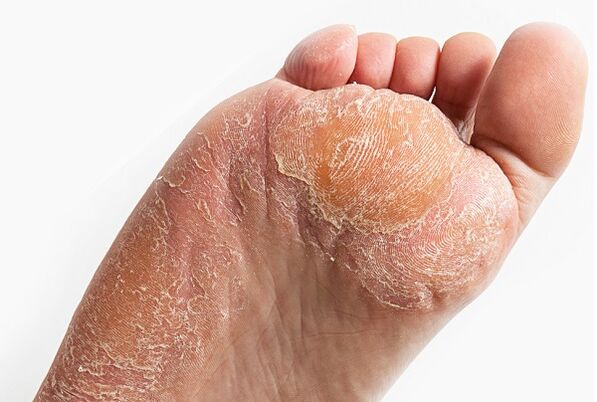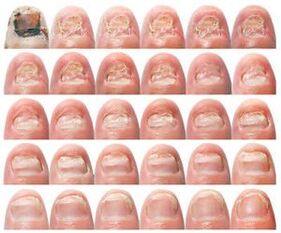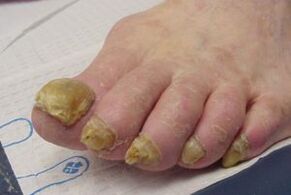The symptoms of toenail fungus, which will be discussed below, are most often seen due to a negligent approach to personal hygiene. In most patients, the symptoms of nail fungus appear suddenly, because the infection is almost invisible and occurs immediately. Because treatment for this disease lasts a long time, it is better for a person who sees signs of the disease on the toenails to see a doctor immediately.

Factors contributing to the development of the disease
The lesion can be caused by yeast, mold or skin fungi. In the first case, it is impossible to diagnose the disease immediately. Symptoms of the disease appear 5-6 months after infection. Peeling of the nail, a slight irritation of the surrounding skin develops. Sometimes the patient suffers from severe itching.
If the disease develops due to a skin fungus, three scenarios are possible:

- The feet, nails and skin of the feet are infected. The fungus can not only spread to the skin of the lower extremities, but also catch the nails on the hands.
- Another type of mycelium only affects the nail of the thumb or little finger. Sometimes such fungi have a transition to the folds between the fingers. Then the skin is affected either in 1-2 layers, or suddenly.
- Another type of disease - fungi are limited to the "occupation" of the nail plate of the little finger or thumb of the lower extremity, but do not spread further.
- The last type of infection is mold. This type of mycelium is usually seen in people with severe immune disorders such as HIV.
In all cases, the appearance of the infection occurs for the following reasons:
- The protective properties of the patient's body fell below the critical level.
- The nail is mechanically damaged.
- The man was wearing very narrow shoes. Blood circulation in the legs was disrupted, which led to the development of infection.
- Some people have anatomical pathology of the feet that contributes to the development of fungi.
- Often, patients diagnosed with obesity suffer from the disease. The disease causes excessive sweating. This creates favorable conditions for the development of the mycelium.
- Fungi develop in patients with diabetes.
To prevent the disease, you should use only clothes, shoes, personal hygiene products. It is recommended to dispose of carpets and shoes in a timely manner.
General symptoms of the disease

In most people, the first signs of nail fungus begin to appear as small whitish spots or streaks on the toenails. Most people don't care, because nothing hurts them, no worries. If you do not start treatment for mycosis on time, then you can start the disease. All nail plates will germinate mycelium, and the skin around the affected nails will begin to swell. In severe cases, the disease spreads to deep tissue structures. This threatens the development of gangrene and amputation of the leg or even the entire leg.
In the second stage of the disease with mycosis, the natural shine of the nail plates disappears. The color of the nails changes. They are yellow with brown or white stripes. The upper and side surfaces of the nail are often deformed. Such changes are obvious.
In the final stage of the disease, the nail plates become very fragile, and the inflammatory process begins on the cuticle. A person can completely lose a nail. But mushrooms do not end there. They continue to spread to all the nail plates, and then penetrate the skin of the foot, that is, they catch the feet.
The patient himself can recognize the disease in the second and third stages, because the nails are yellow or brown (sometimes black). Rises from the nail bed, acquires increasing fragility, breaks quickly.
Symptoms of the disease in the early stages
If a person has developed fungus on the toenails, at first there are virtually no symptoms of the disease. But then, 2-3 months after the fungus penetrates the skin and sticks to the nails, you can see the manifestation of the following symptoms of the disease:
- A slight redness first appears on the surface of the skin near the affected plate.
- Then the person feels a burning sensation in this area.
- Severe itching develops, inflammation begins.
- Later, areas with increasing humidity develop in these areas.
- There is a thickening of the nail and its keratinization.
A person should be examined as soon as they see these signs of nail fungus and then start treatment.
In the later stages of the development of mycosis, depending on the type of fungal infection, the patient's nail plate is painted in different colors. In the early stages of the disease, the affected area may turn white or green. The spots on it will be located along the surface or will look like round dots. At the same time, in most patients, the thickness of the plaque does not change, and in many cases the nail retains its natural shine. In all cases, the itching is so severe that it is impossible to get rid of it immediately. If the patient sees signs of mycosis in time, then you can get rid of burning and itching with the use of Miconazole, Clotrimazole and similar drugs. But you should not treat yourself, it is better to do it under the supervision of a doctor. In case of any mistake or failure to follow the doctor's recommendations, the mycelium will immediately spread to healthy areas, which complicates treatment.
Further development of the disease
Fungus on the toenails, if left untreated, can deprive the nails of their natural color and the surface of the affected area will turn yellow. There is delamination on the nails. They can begin to disintegrate. In addition, the patient develops intolerable itching of the skin around the affected area. The nail plate material begins to crack. Combustion intensifies. Some patients may develop dysbacteriosis, feel unwell, and complain of weakness throughout the body. Perhaps the development of drowsiness.

First, the mycelium completely changes the color of the surface of the plates, and then they begin to thin. Then the patient's nail is rejected and the infection penetrates the skin structures. Itching gets worse.
In the final stages of the disease, the surface of the patient's nail plates resembles scales. Depending on the type of fungus that strikes a person, the nails begin to thicken and delaminate. They break quickly. Symptoms include:
- Slab contraction joints should intersect at the openings for columns. Sometimes this causes pain in the patient.
- Slab contraction joints should intersect at the openings for columns and should intersect at the openings for columns.
- The color of the affected area changes from yellow to black.
- Parts of the plates begin to penetrate the skin.
- A whitish or yellowish coating appears under the nails. This is due to their stripping from the bed.
- The itching is very strong, almost unbearable. Burning of the skin around the affected areas increases again.
If these symptoms appear and treatment is started on time, then it will still last a long time. You can get the disease in 4-5 seconds and it is very difficult to treat the disease. This usually lasts from 3 to 6 months. It is not recommended to abandon the course of treatment due to possible complications that may lead to surgery. So you need to listen to yourself carefully. If the first symptoms are detected and treatment is started immediately, in addition to saving your nails, there is a chance to complete the therapy faster.





























